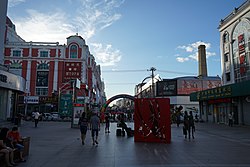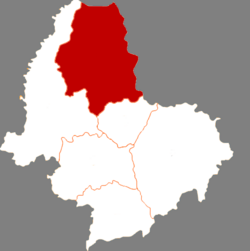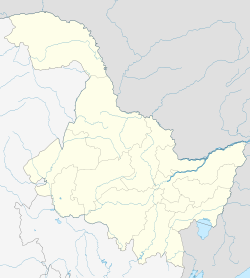Aihui District (simplified Chinese: 爱辉区; traditional Chinese: 愛輝區; pinyin: Àihuī Qū) is an administrative district and the seat of the prefecture-level city of Heihe, Heilongjiang Province, China. It is located on the right (south-western) bank of the Amur River, across which is Blagoveshchensk, Amur Oblast, Russia. Aihui District spans an area of 1,443 km2 (557 sq mi), and had a population of 192,764 as of 2000.[2]
Aihui
爱辉区 | |
|---|---|
 | |
 Location of Aihui District within Heihe | |
| Coordinates: 50°14′28″N 127°29′36″E / 50.24111°N 127.49333°E | |
| Country | China |
| Province | Heilongjiang |
| Prefecture-level city | Heihe |
| Township-level divisions |
|
| District seat | Huayuan Subdistrict |
| Area | |
• Total | 1,443 km2 (557 sq mi) |
| Elevation | 134 m (440 ft) |
| Population (2020 census)[1] | |
• Total | 223,832 |
| • Density | 160/km2 (400/sq mi) |
| Time zone | UTC+8 (China Standard) |
| Postal code | 164300 |
| Area code | 0456 |
| Website | www |
Names
editAihui has undergone a number of name changes throughout its history, including Aihui (simplified Chinese: 瑷珲; traditional Chinese: 璦琿; pinyin: Àihuī), Aihun (simplified Chinese: 艾浑; traditional Chinese: 艾渾; pinyin: Àihún), Aihu (simplified Chinese: 艾浒; traditional Chinese: 艾滸; pinyin: Àihǔ), and Aihu (simplified Chinese: 爱呼; traditional Chinese: 愛呼; pinyin: Àihū).[2] Most recently, in 1956, the area's Chinese characters were changed from Aihui (simplified Chinese: 瑷珲; traditional Chinese: 璦琿; pinyin: Àihuī) to the present Aihui (simplified Chinese: 爱辉; traditional Chinese: 愛輝; pinyin: Àihuī), due to the uncommon nature of the former name's characters.[2]
History
editThe area of present-day Aihui has been occupied on-and-off by various Chinese dynasties dating back to the Tang dynasty.[2]
Qing dynasty
editTo fend off military Russian military forces invading the area, Qing dynasty forces were stationed in present-day Aihui in 1683.[2]
In 1685, the city of Aihui (simplified Chinese: 瑷珲; traditional Chinese: 璦琿; pinyin: Àihuī) was built on orders from the Yamen of Heilongjiang.[2] In the subsequent two centuries since its founding, Aihui served as one of the most important towns of Northern Manchuria.[citation needed]
Following the Boxer Rebellion the city was briefly occupied by Russia, until 1906, when it was returned to the Qing dynasty.[2]
Republic of China
editIn 1913, Aihui incorporated as Aihui County (simplified Chinese: 瑷珲县; traditional Chinese: 璦琿縣; pinyin: Àihuī Xiàn).[2]
From December 1934 to 1945, the city was ruled by the Japanese puppet-state of Manchukuo.[2]
On December 11, 1956, was renamed Aihui County (simplified Chinese: 爱辉县; traditional Chinese: 愛輝縣, pronunciation unchanged).[2] On November 15, 1980, Heihe City was created, and on June 6, 1983, Aihui County was abolished, being merged into the Heihe City.[3]
To further complicate the situation, in 1993 the former Heihe City (a county-level administrative unit) was reorganized into Aihui District (also a county-level unit), while the former Heihe Prefecture (黑河地区) became Heihe Prefecture-level City (which consists of Aihui District and a number of counties).[3] This administrative division has been in effect ever since.
Geography
editThe Fabiela River and the Gongbiela River both run through the district.[4] Much of the district is forested, particularly in the west.[4] The primary trees of Aihui District are larch, red pine, poplar, and birch.[4]
The district shares a 184.3 kilometres (114.5 mi) border with Russia, and faces the Russian city of Blagoveshchensk.[5]
Administrative divisions
editAihui is divided into 4 subdistricts, 3 towns, 5 townships, 3 ethnic townships, and 23 other township-level divisions.[2][6]
The district's four subdistricts are Huayuan Subdistrict (花园街道), Xing'an Subdistrict (兴安街道), Hailan Subdistrict (海兰街道), and Xixing Subdistrict (西兴街道).[2][6]
The district's three towns are Xigangzi (西岗子镇), Aihui (瑷珲镇), and Handaqi (罕达汽镇).[2][6]
The district's five townships are Xingfu Township (幸福乡), Shangmachang Township (上马厂乡), Zhangdiyingzi Township (张地营子乡), Xifengshan Township (西峰山乡), and Erzhan Township (二站乡).[2][6]
The district's three ethnic townships are Sijiazi Manchu Ethnic Township (四嘉子满族乡, Manchu: ᠰᡟ ᡥᡳᠶᠠ ᠰᡳ᠋ ᠮᠠᠨᠵᡠ ᡠᡴᠰᡠᡵᠠ ᡤᠠᡧᠠᠨ), Kunhe Daur and Manchu Ethnic Township (坤河达斡尔族满族乡, Manchu: ᡴᡡᠨ ᠪᡳᡵᠠ ᡩᠠᡥᡡᡵ ᠮᠠᠨᠵᡠ ᡠᡴᠰᡠᡵᠠ ᡤᠠᡧᠠᠨ), and Xinsheng Oroqen Ethnic Township (新生鄂伦春族乡).[2][6]
The district also has 23 other township-level divisions, which include mines, farms, forestry areas, and other similar operations which have township-level status.[2][6]
Demographics
editAbout 18,500 persons (9.4% of the entire population) belong to ethnic minorities.[3] Aihui is home to 26 different ethnic groups, including Han Chinese, Manchu, Hui, Daur, Oroqen, Korean, and Mongol populations.[5]
As of the 1990s, the village of Dawujia (Chinese: 大五家子屯), located in the district, remained one of the few pockets where the Manchu language was commonly spoken.[7]
Economy
editThe district is home to proven reserves of 69 different types of minerals.[5] Provel coal reserves total 1.1 billion tons, proven gold reserves are 80 tons, proven silicon reserves are 1 million tons, and proven limestone reserves total 12 million tons.[5] There are also sizable reserves of marble, basalt, perlite, and quartz sand.[5]
Transportation
editNational Highway 202 runs through the district, as does the Bei'an-Heihe railway.[4]
References
edit- ^ "2020年黑河市第七次全国人口普查主要数据公报" (in Chinese). Heihe Municipal People's Government. 2021-05-28.
- ^ a b c d e f g h i j k l m n o p 爱辉区历史沿革 [Aihui District Organizational History]. www.xzqh.org (in Chinese). 2013-02-21. Archived from the original on 2017-08-21. Retrieved 2021-02-10.
- ^ a b c 爱辉区概况 (in Chinese (China)). Heihe People's Government. 2007-06-06. Archived from the original on 2012-12-25. Retrieved 2009-03-29.
- ^ a b c d 爱辉区概况地图 [Aihui District Overview]. xzqh.org (in Chinese). 2013-02-21. Archived from the original on 2017-08-17. Retrieved 2021-02-10.
- ^ a b c d e 爱辉区概况 [Aihui District Overview] (in Chinese). Heihe Municipal People's Government. 2013-03-15. Archived from the original on 2021-02-10. Retrieved 2021-02-10.
- ^ a b c d e f 2020年统计用区划代码(爱辉区) [2020 Statistical Division Codes (Aihui District)] (in Chinese). National Bureau of Statistics of China. 2020. Archived from the original on 2020-11-29. Retrieved 2021-02-10.
- ^ Kane, Daniel (1997). "Language death and language revivalism The case of Manchu". Central Asiatic Journal. 41 (2): 231–249. ISSN 0008-9192. JSTOR 41928113.
